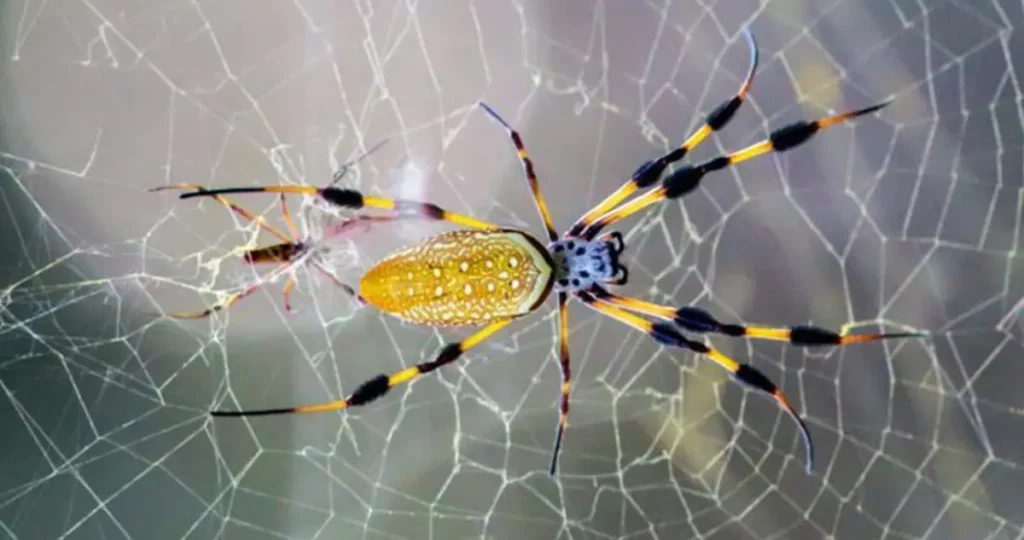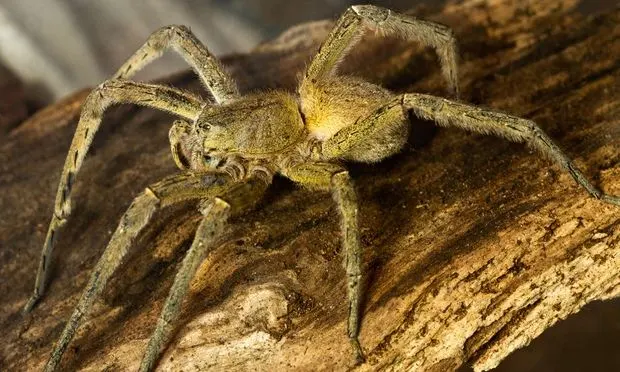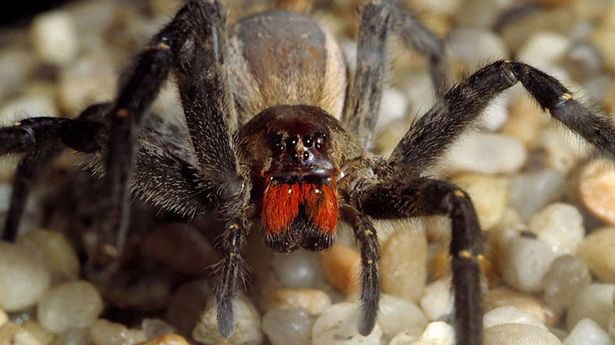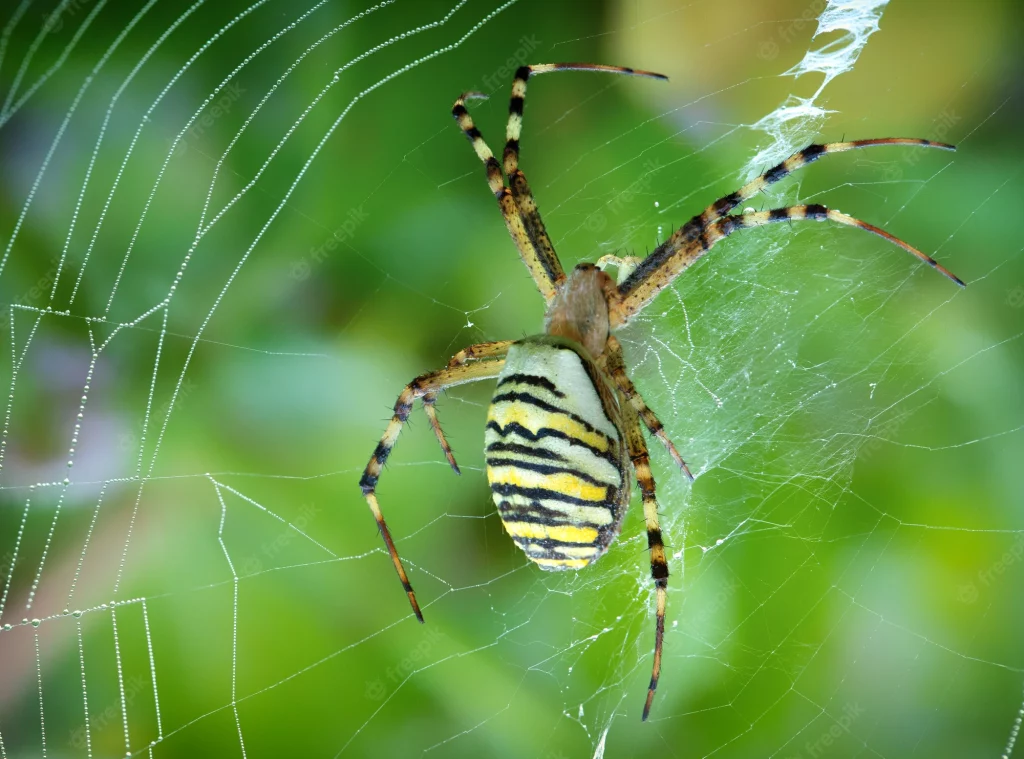The name “banana spider” is given to both spiders that resemble bananas and those that have been discovered in banana shipments.
Banana spiders are well-known for their eye-catching yellow hue and are widespread in the jungles of Central and South America, as well as some parts of Asia, Australia, and the US.
Fortunately, Americans hardly ever come across this species of spider. Although American banana spiders are capable of biting, their bites and stings are not as severe or damaging as those from other spiders like brown recluse or black widow spiders.
What Is A Banana Spider?
There are numerous spider species that go under the umbrella title “banana spider.” The name is used by two families and numerous subspecies. The name “banana spider” has a few potential etymologies.
The obvious explanation is that they are yellow, brown, and black in color, but it’s also possible that name relates to the golden silk that some of them use to weave their webs.
Additionally, certain species like to hide themselves behind banana leaves or inside banana shipments, so that might also play a role.
It might possibly be a combination of all of these things! Banana spiders can be found all over the world, thus it’s probable that various cultures gave them various names.
Banana Spider Size
The banana spider, also known as the golden silk orb-weaver, can reach a size of about 2-3 inches (5-7.5 cm) in length. These large spiders are known for their vibrant yellow color and the strong webs they weave, often found in tropical regions.
Banana Spider Types
Banana spiders are widely believed to be highly poisonous, while some claim they are absolutely harmless and that their bite hardly equates to a bee sting. Any of the three options is the proper response. You must first identify the type of banana spider in order to ascertain whether it is poisonous.
Africa, Asia, North America, and Oceania all have the five main species of banana spiders. However, the amount of venom in these banana spiders varies depending on the species.
1. Golden silk orb-weaver

Because of the shape of its body, this species is sometimes known as a calico spider, a writing spider, or a golden orb spider. Trichonephila clavipes is its scientific name, and it belongs to the Nephila family of spiders. The enormous wood spider belongs to this family as well.
Although it can bite when threatened, people are not poisoned by its venom. It is regarded as mainly risk-free.
They are white, black, brown, orange, yellow, and black in color. They are mainly found in the southeast of the United States. They favor open spaces and high humidity levels. They can be found near pathways and clearing margins in forests.
Greek for “loving of spinning” is Nephila. Webs up to three feet across can be woven by a golden silk orb weaver. These webs are made of extremely robust silk.
Kevlar, a fabric used to build bulletproof vests, is not as strong as the silk produced by the golden silk orb-weaver.
Different types of silk glands found in female spiders enable them to spin webs that are both sturdy and aesthetically pleasing.
2. Brazilian Wandering Spider

The Brazilian wandering spider had previously been listed as the world’s most venomous spider by Guinness World Records.
Because it occasionally turns up in banana shipments, this spider is also known as the “banana spider.” Other names for the spider include the huntsman spider and the armed spider.
There were just seven instances of Phoneutria spiders in banana shipments worldwide between 1926 and 2009.
The Brazilian wandering spider can grow to a length of 2 inches (50 mm), and its venom can be dangerous to people. Except for people under the age of 10 and those over the age of 70, it rarely causes death in humans.
A 2018 study found that although this type of spider bites about 4,000 individuals annually, less than 5% of these bites are severe. Less than 3% of victims of a bite require antivenom, and most of the time just treating the symptoms is sufficient.
Only two of the 15 deaths recorded in Brazil since 1903 that may have been caused by a bite from this spider were actually confirmed.
3. Red-Faced Banana Spider

Since they are the most common variety, this is probably what most people picture when they hear the word “banana spider.” Its unique feature is a red hourglass marking on the abdomen.
They generally reside in and around banana plants, which is how they got their name. They use the broad flat leaves as cover and food, and they frequently feast on animals drawn to the ripening fruit’s aroma.
They are not particular. In addition to the normal flies, moths, crickets, and cockroaches, they may also take down objects that are considerably bigger than them because they are heavy creatures with massive, thick bodies.
One of the few spider species that can kill things like frogs and lizards is this one.
These banana spiders are avid hunters, which is another interesting aspect about them. They are referred to as “wandering spiders” because they hunt for their meal rather than creating webs and waiting for the prey to approach them.
They control their prey using a highly sophisticated neurotoxic venom.
But don’t be alarmed. Although this kind of spider is relatively innocuous to people, banana spiders are devastating to their enemies. They claim that their bite feels “like a bee sting.”
4. Hawaiian Garden Spider

These small spiders, which are a common variety of banana spider, have black, brown, and yellow bodies that extend into orange legs with two bands. Their abdomens, which are formed like a king’s crown, are another way to recognize them.
In warm, humid island climates in nations bordering the Pacific Ocean, such as Taiwan and Australia, Argiope Appensa are frequent. They are referred to as “Hawaiian garden spiders” in Hawaii because they enjoy relaxing among the vegetation.
They pose no threat. Like other members of their family, they have a small, hardly harmful bite. Since they will eliminate pests and other annoyances, many gardeners really welcome their presence.
However, these enigmatic critters also embellish their webs with “stabilimenta.”
Stabilimenta are essentially ostentatious web embellishments. Banana spiders produce vivid, noticeable zig-zag patterns formed of dense white webbing.
It has been suggested that these ornamental components serve as barriers to prevent huge animals from unintentionally flying or charging into the web and destroying it.
5. Tiger Spider

In cities like Sydney, Australia, this banana spider is a common sight in and around yards and homes. It has many traits with Nephila spiders due to their shared family tree, including a mild bite and a fondness for creating intricate webs made of golden thread.
This species can be differentiated from its relatives by a few features. First, it has long, black legs with bands of color that are yellow and orange; as a result, it is occasionally referred to as a “tiger spider.”
Symptoms of a Banana Spider Bite
There aren’t many distinguishing characteristics that can be used to identify a spider bite.
They can resemble several different bug bites in appearance. They can also resemble other bacterial and other illnesses, according to a 2011 study.
This makes it difficult to detect a spider bite unless the victim takes the spider that bitten them to the doctor.
Generally spider bit can cause ;
- Inflammation in the biting area.
- An itch or rash.
- The bite is causing discomfort all throughout.
- Cramping or muscular ache
- Blisters.
- Headache.
- Vomiting and nauseous.
- Sweats, chills, and fever.
- Having trouble breathing
- A rise in blood pressure
- Either anxiety or restlessness.
Blisters on fair-skinned individuals will develop reddish purple in color. They may look as a lumpy or bumpy cluster of sores that are darker than the surrounding skin in people with dark skin tones.
Are Banana Spiders Venomous?
The venom that most spiders produce is typically not deadly enough to do serious harm, yet most of them will bite if they feel threatened. Most spiders that people refer to as banana spiders are like this.
The amount of venom, the site of the spider’s bite, the length of the bite, age, and health status all affect how severely people react to spider venom. Death from a spider bite is rare.
The Brazilian wandering spider, a particular kind of banana spider, can occasionally produce severe symptoms. In the United States, this kind of spider is unusual.
Brazilian wandering spider bite can lead to
- ache close to the bite.
- swelling.
- redness.
- agony that spreads.
- sweating.
- stinging, numbness, or burning.
- In more serious situations, there could be
- Increased blood pressure.
- Cyanosis due to a shortage of oxygen and a fast heartbeat.
- Diarrhea.
- Shock and, in rare instances, fluid on the lungs.
- Skin that is pale might seem blue due to cyanosis.
- Lips, gums, the tongue, and the skin behind the nails could all have a blue tint on those with darker skin.
Although any sort of banana spider bite can be unpleasant, it is not as dangerous as bites from other spiders like the black widow spider or the brown recluse spider bite.
An individual who was bitten by a Cupiennius coccineus spider described an excruciating pain that resembled a bee sting as the fangs penetrating their skin, followed by discomfort and numbness for 10 minutes.
The majority of symptoms disappear after 30 minutes.
The bite from Golden Silk Orb-Weaver spider is only likely to be dangerous if you hold it or pinch it. Where the spider bit you, you could experience discomfort and see some redness, but these symptoms normally go away soon.
The pain is often not as bad as a bee sting.
Other Phoneutria species have less venomous bites. A Phoneutria boliviensis spider bite may result in pain that lasts for 24 hours without any other symptoms.
Humans are unlikely to be in risk from a bite from Hawaiian Garden Spider Bite.
Home Treatment for a Spider Bite
Medical care is rarely required for bites from non-venomous spiders. As was already noted, there are numerous ways to treat the signs of a nonvenomous spider bite.
The following actions can typically be used to cure a banana spider bite at home:
- Don’t panic.
- After washing the bite area with soap and water, dry it with a fresh towel.
- Elevate the bite if you can to improve the blood flow.
- For 10 minutes at a time, place an ice pack with a cloth covering on the bite. As a result, the stinging and swelling will lessen.
- Take an over-the-counter (OTC) pain treatment, like ibuprofen, if the pain doesn’t go away.
- Apply an antibiotic ointment to the area if it begins to blister to lower the chance of infection.
- To stop itching, use an antihistamine or corticosteroid cream. To relieve your symptoms, you can also take antihistamines like diphenhydramine (Benadryl).
A home treatment for a spider bite may be possible using some natural remedies. Although there is now little scientific evidence to support their use in wound healing, if people want to give them a try, their use is probably harmless.
Following are a few tried-and-true all-natural treatments for spider bites:
Turmeric paste
The anti-toxin properties of turmeric include the ability to counteract the poison that spider bites release. The redness, discomfort, and inflammation brought on by a spider bite are reduced by the turmeric’s antibiotic and anti-inflammatory effects.
Aloe Vera Gel
For the treatment of many skin issues, aloe vera has been recommended multiple times. This includes bites from spiders. Numerous essential substances, including vitamins, enzymes, minerals, and fatty acids, are present in the plant’s leaf.
These elements aid in reducing the itching and inflammation caused by a spider bite.
Activated Charcoal
When a spider bite occurs, activated charcoal works very well as a therapy. The sufferer heals more quickly because to the charcoal’s ability to lessen the effects of the spider’s poison.
Baking Soda Paste
We all know there are many uses for baking soda in our homes, but few are aware of how crucial it is for treating spider bites. In fact, it is one of the most affordable solutions for treating spider bites.
Draw a small quantity of baking soda, around a teaspoon worth, then add water to create a thick paste.
Water and baking soda should be combined in a ratio of around 3:1. After five minutes, wash off the baking soda paste that you applied to the wound.
When To Talk with a Doctor?
It’s important that you visit a doctor as soon as you can if you’ve been bitten by a spider whose venom you believe to be dangerous to humans.
Although many people who get bitten by spiders don’t experience severe reactions, if a problem does occur, it could be very serious.
It’s vital to seek medical attention if you develop an allergic reaction, particularly if you have difficulty breathing or swallowing or experience heart palpitations, even if you just received a little bite from a nonvenomous spider.
Additionally, get medical help if any of your symptoms seem severe, if they are growing worse rather than better, or if the spider bite has developed an infection.
Speak with a healthcare provider to find out if the spider that bit you is dangerous if they are unclear. An accurate diagnosis can result in more efficient therapy and quicker recovery.
To identify the spider, try to capture it or snap a picture of it.
Interesting Facts of the Banana Spider
There are various reasons to be grateful if you see a Hawaiian banana spider or golden orb-weaver in your yard. They feed on small- to medium-sized pests that can be a nuisance, such as mosquitoes.
Researchers have tried to use the super-strong silk produced by golden orb-weavers in many different ways, including as a fabric for clothing.
Although they haven’t yet worked out how to employ the strength of this silk on a wide scale, researchers are still investigating this spider and its web.



